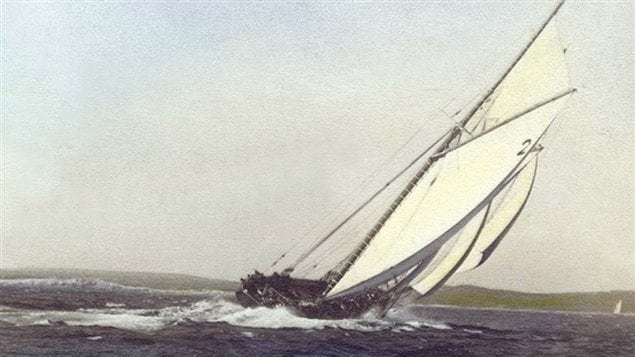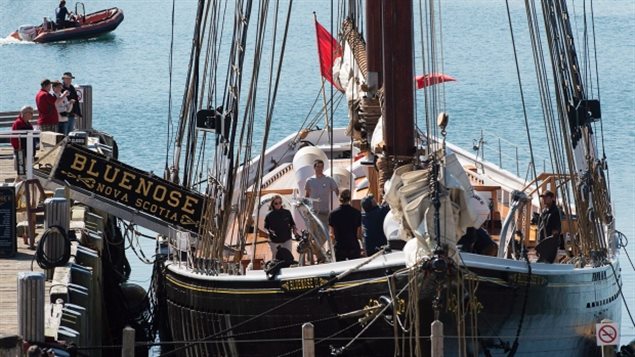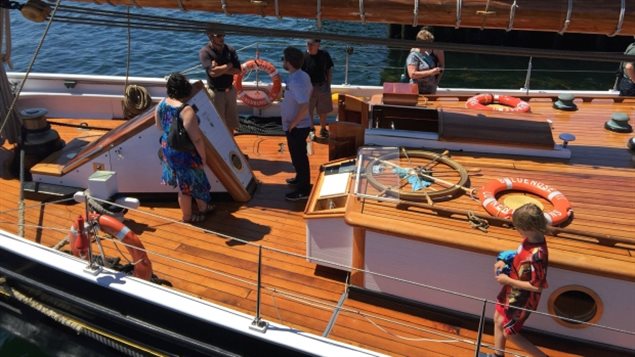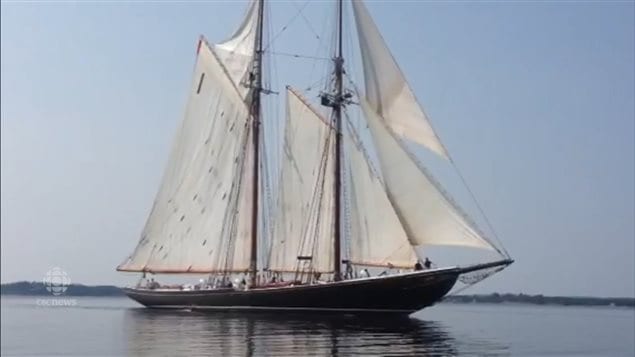The Bluenose schooner is one of the most iconic and recognized symbols of Canada.
Canadians see it every day on their 10-cent coin.
The latest version of these sleek sailing vessels is now on a tour of the east coast province of Nova Scotia, where both original, and replicas have been built.
But she’s dogged by controversy, and costs.
The east-coast schooners of Canada and the US, were sleek, but hard-working fishing vessels that operated far off the Atlantic coast on the Grand Banks, and were built
in the fading days of sail. Even though they were to carry huge cargoes of fish, the sleekness of the design was to give speed, all important to the owners and crew, as the first back from the fishing grounds would get the highest prices.
Unofficial races back to shore perhaps 100 or more nautical miles, were common. Soon American and Canadian crews were taunting each other.

This grew to an official series,for the International Fisherman’s Trophy. pitting American and Canadian working schooners against each other.
The original Bluenose was not only extremely profitable, but fast. For years she beat every ship the Americans put up against her, and as such became the pride of Canada. She beat every ship the Americans built to pit against her and was undefeated from 1921 -1938,
But wooden ships don’t last long, and soon she was gone.
The legend lived on and in the 1960’s a replica Bluenose II was built and ended up being a sailing ambassador for the province of Nova Scotia and Canada. That too eventually was in dire need of repair and so the province decided that a new Bluenose be built.

Alas, new safety and other rules insisted upon by an American ship registry, caused the project to be years behind schedule and many millions over budget.
Critics constantly blame various successive governments for bungling the management and costs.
Finally however, this summer she’s sailing once again, but again amidst controversy.
The original Bluenose was designed, built, and launched within 6 months from late 1920 to March 26, 1921, and the cost was $35,000. In today’s money that would be $460,000.
The new Bluenose, has taken six years and is currently at $20 million and still counting, and there are ongoing problems with the expensive rudder and steering system.
A January 2015 report from the provincial auditor-general, is highly critical of the way the entire project has been managed.
Words like “deficient”, “lack of planning” , “basic principle of project management not followed” pepper the document.
Even now as the ship is on a goodwill tour, the steering is still giving problems.

The original design called for a wooden rudder and an 11-inch wooden shaft (attaching the rudder to the steering gear), as has been the design through generations of the ships.
For cost reasons the American Bureau of Shipping (ABS) was hired to certify seaworthiness, as opposed to the experienced Lloyd’s Register, even though ABS has no experience in wooden sailing vessels. Used to registering steel cargo carriers they demanded all kinds of modifications, going against over a century of wooden ship-building experience in the province. This included a requirement for a 21-inch shaft.
This couldn’t work in the design, so a thinner steel shaft was substituted. Now a much much heavier and non-buoyant steel rudder had to be made to mate to the steel shaft, along with complicated and costly hydraulics to move it ($700,000).
On several occasions this summer, sailings have been cancelled due to steering problems.
Lou Boudreau, an experienced schooner captain is quoted in the Herald news saying, “they’re just band-aiding it one time after another. The government has to realize it won’t work”.
He points out that steering failures have come during harbour cruises in what are the least challenging conditions the ship could face.

He says the rudder system should be removed and replaced with a composite brass and wood one, which would be a fraction of the weight of the present one.
“You don’t go down a road that you know is a wrong road just because some American agency is telling you to do it.” saying a composite rudder could be made for $50,000 to replace the $700,000 steel system.
He says the good reputation of Lunenburg shipwrights and shipbuilders is taking the hit. But ask any one of them, and Boudreau says they would solve the problem.
“They’ll tell you put a good old fashioned Lunenburg rudder on there with a Lunenburg foundry worm gear. Those systems have been sailing schooners to the Grand Banks for generations.”
He adds, “The problem started when government started sticking their fingers in the pie and telling people what to do.”







For reasons beyond our control, and for an undetermined period of time, our comment section is now closed. However, our social networks remain open to your contributions.